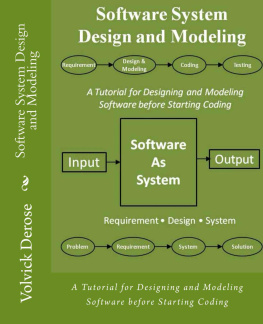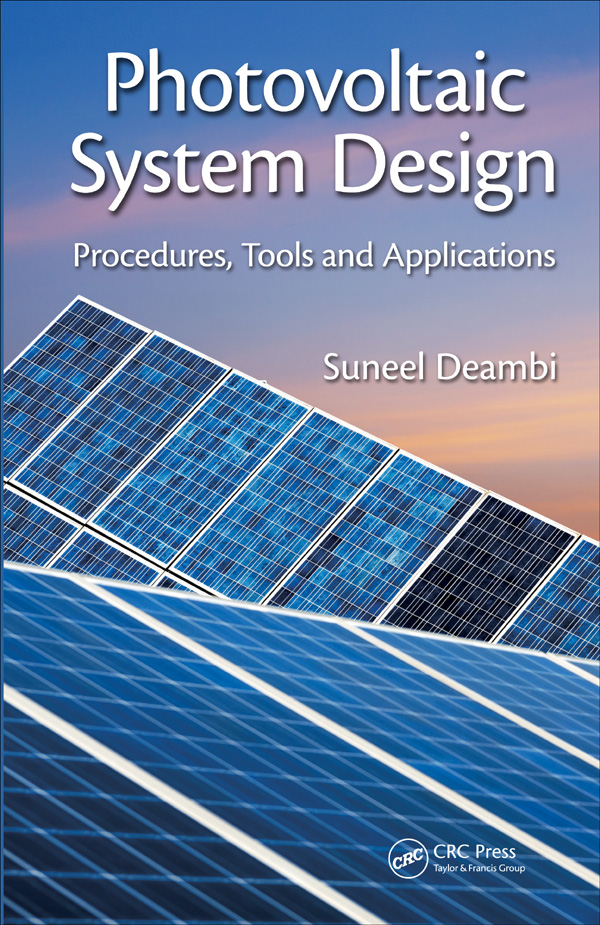Deambi - Photovoltaic System Design: Procedures, Tools and Applications
Here you can read online Deambi - Photovoltaic System Design: Procedures, Tools and Applications full text of the book (entire story) in english for free. Download pdf and epub, get meaning, cover and reviews about this ebook. City: Milton, UNKNOWN, year: 2016, publisher: CRC Press, genre: Romance novel. Description of the work, (preface) as well as reviews are available. Best literature library LitArk.com created for fans of good reading and offers a wide selection of genres:
Romance novel
Science fiction
Adventure
Detective
Science
History
Home and family
Prose
Art
Politics
Computer
Non-fiction
Religion
Business
Children
Humor
Choose a favorite category and find really read worthwhile books. Enjoy immersion in the world of imagination, feel the emotions of the characters or learn something new for yourself, make an fascinating discovery.

- Book:Photovoltaic System Design: Procedures, Tools and Applications
- Author:
- Publisher:CRC Press
- Genre:
- Year:2016
- City:Milton, UNKNOWN
- Rating:3 / 5
- Favourites:Add to favourites
- Your mark:
Photovoltaic System Design: Procedures, Tools and Applications: summary, description and annotation
We offer to read an annotation, description, summary or preface (depends on what the author of the book "Photovoltaic System Design: Procedures, Tools and Applications" wrote himself). If you haven't found the necessary information about the book — write in the comments, we will try to find it.
Abstract: Introducing a Reliable Green Technology That Can Help Improve System PerformanceSolely centered on photovoltaic (PV) system sizing and the tools used for PV system analysis and design, Photovoltaic System Design: Procedures, Tools and Applications emphasizes the importance of using solar PV technologies for a number of end-use applications, and examines growing interest in solar PV-based projects on a global scale. Written for the system designer/project developer/manufacturer dedicated to correctly sizing a PV system, the book outlines various aspects of PV technology, applications, and programs. It describes key attributes, system design requirements, influence on climatic and site-specific parameters, utilization of simulation procedures, and expected performance. The author includes actual case studies for system designing procedures adopted by various companies and provides a framework for working through both direct and indirect variables under the actual system designing phase. A vital resource essential to your collection, this book:Touches upon the role of renewable energy technologies in a holistic energy scenarioMakes a clear categorization of off-grid and on-grid PV applications and discusses advantages and limitationsConsiders the potential of solar radiation availabilityIntroduces PV system sizing procedures via the modern use of simulation softwaresPresents an analysis of actual PV power plant sites when designed via the use of simulation softwareDetermines the weak links in a PV systemBrings out the importance of capacity building initiatives vis-a-vis the available range of PV simulation software, tools, and proceduresPhotovoltaic System Design: Procedures, Tools and Applications provides a clear understanding of the issues that can affect the operation and smooth running of PV facilities and aids in determining photovoltaic system sizing procedures from a variety of end-use considerations. The book encompasses civil, mechanical, electrical, geotechnical, and power systems engineering and is useful to industry professionals involved in solar power plant design.
Deambi: author's other books
Who wrote Photovoltaic System Design: Procedures, Tools and Applications? Find out the surname, the name of the author of the book and a list of all author's works by series.





